Santa Cruz Vala
Wheel Size: 29’’ front / 27.5’’ rear
Suspension Travel:
- Frame travel: 150 mm
- Fork travel: 160 mm
Geometry Highlights:
- Sizes offered: S, M, L, XL, XXL
- Headtube angle: 64.2° (High), 63.9° (Low)
- Reach (size L): 480 mm (High), 477 mm (Low)
- Chainstay length (size L): 443 mm (High), 444 mm (Low)
Frame Material: Carbon fiber
Price: Complete bikes starting at $7,299 (build details below)
Blister’s Measured Weight (Santa Cruz Vala, size Large): 46.39 lbs / 21.01 kg
Test Locations: Colorado, New Mexico
Reviewer: Simon Stewart (6’, 170 lbs / 183 cm, 77.1 kg)
Test Duration: 4 months
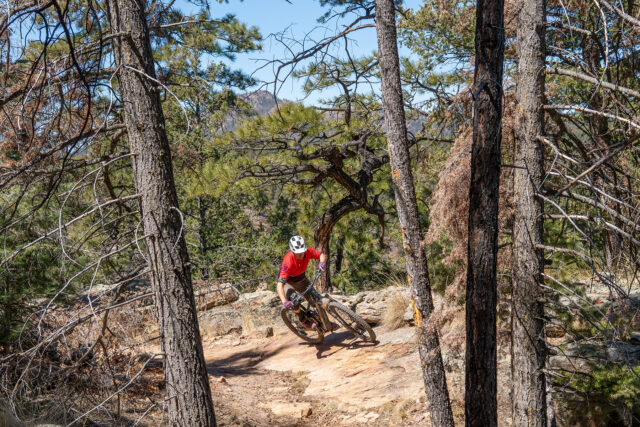
Intro
While many riders can still remember when the Heckler and Bullit weren’t eMTBs but more budget-oriented single-pivot bikes, Santa Cruz long ago pushed their entire lineup over to the brand’s signature VPP suspension platform. With new releases like the 2025 Bronson and Hightower, their continued commitment to the VPP platform is quite clear — so it came as a surprise when we learned about the new Vala eMTB and its move to a four bar, acronym-free suspension layout.
Of course, there’s a lot more here to talk about than the suspension design, like the Bosch Performance Line CX motor, thoughtful finishing details, and both suspension and geometry adjustments. So, let’s get into it.
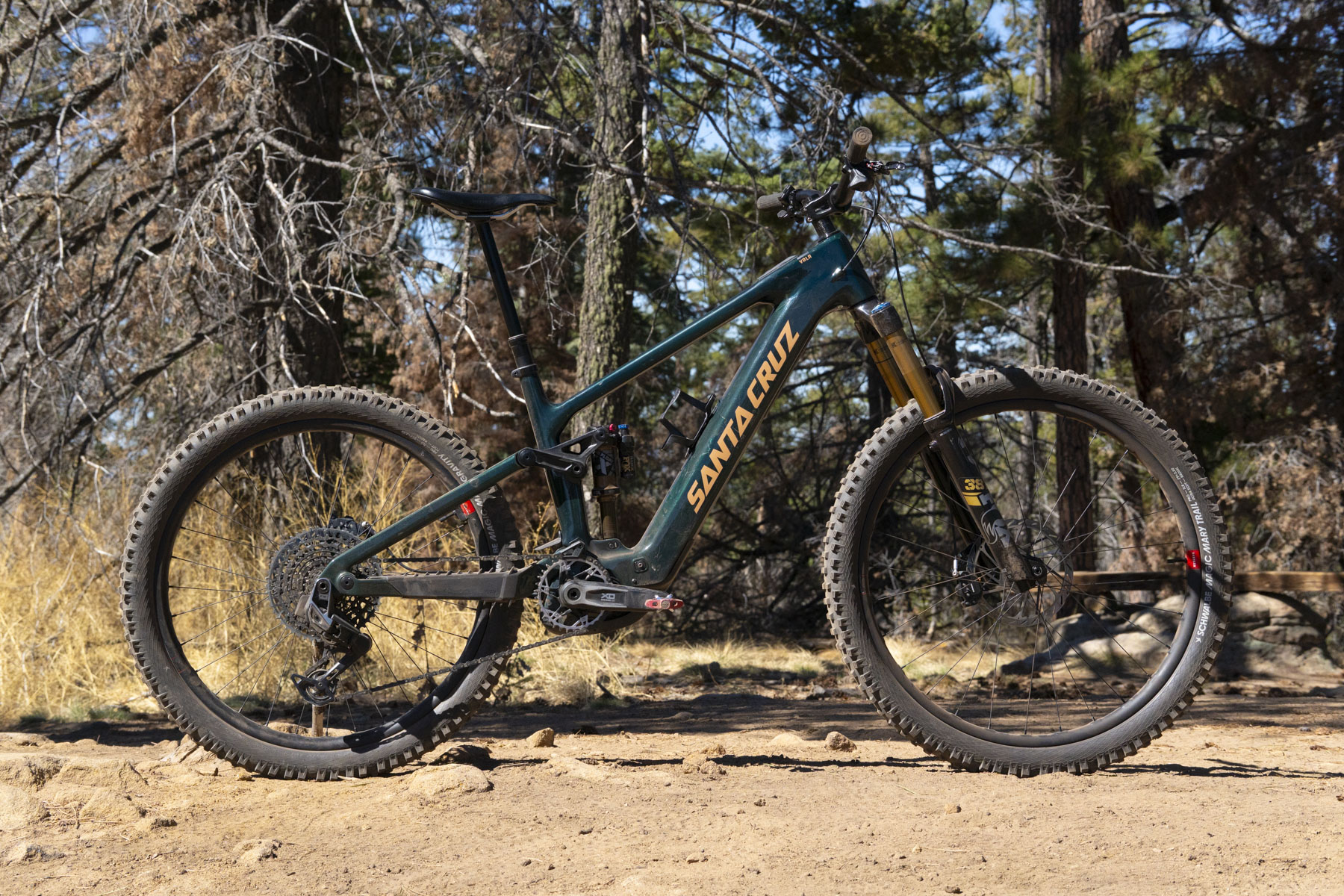
The Frame
I’ll be honest — I’m so conditioned to seeing that signature VPP-equipped Santa Cruz silhouette, the Vala had me puzzled at first sight. Knee-jerk confusion aside though, it’s a sleek and purposeful design that still hides a whole bunch of impressive little details.
First off, the Vala is a mixed wheel affair. This seems to be an increasingly common trend as eMTB manufacturers try to design geometry around sizable motors, but also due to the somewhat more playful feel that a smaller 27.5’’ wheel can bring to a hefty eMTB.
The Vala’s 150 mm of travel is provided by a Horst Link four bar design, meaning that the rear triangle has a pivot at the chainstay just below the rear axle. According to Santa Cruz, building a frame around a large full power motor would require too many compromises in pivot placement with a VPP design. In order to get the suspension performance that the team wanted, Santa Cruz moved to a four bar arrangement which allows for much simpler packaging of the main pivot.
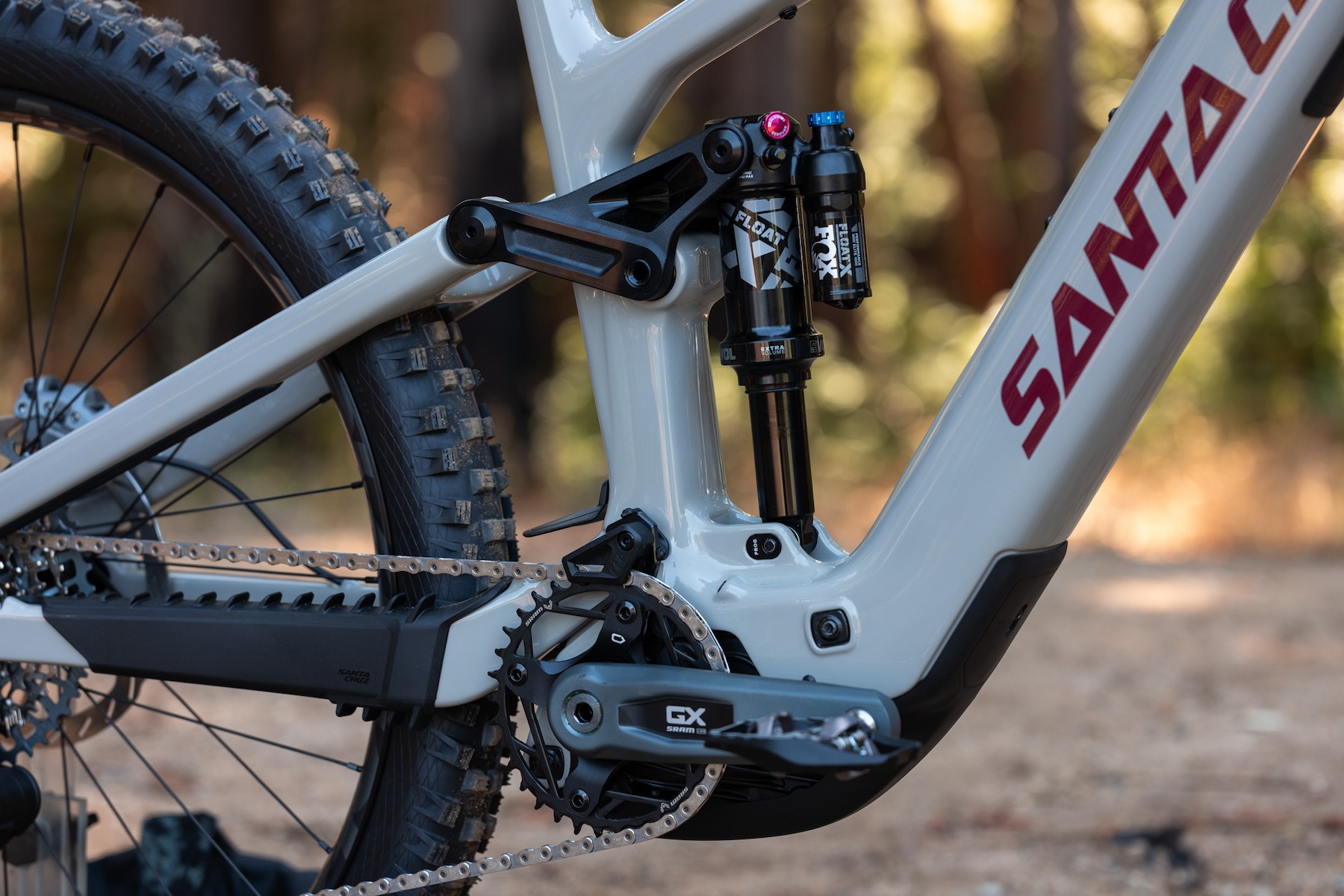
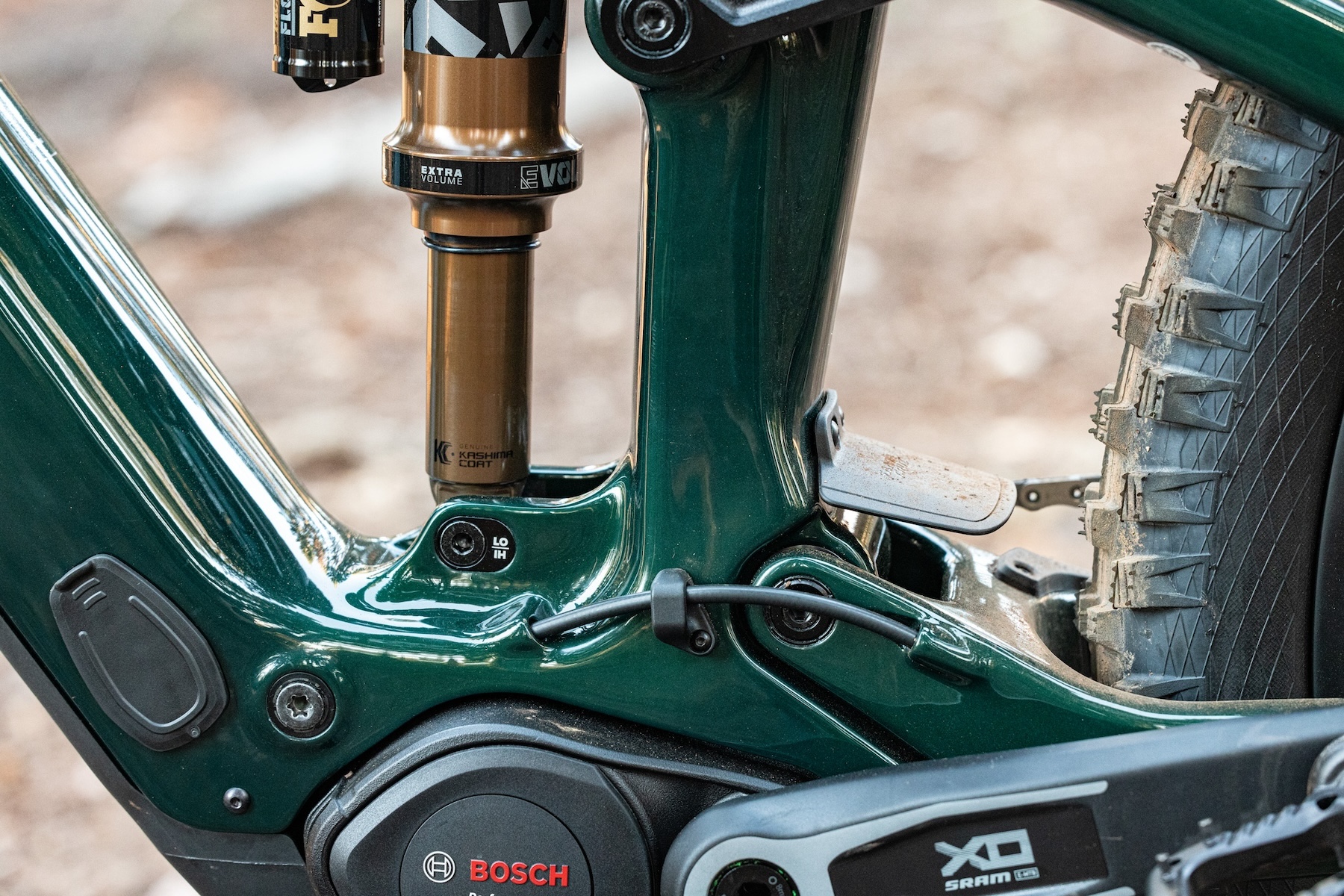
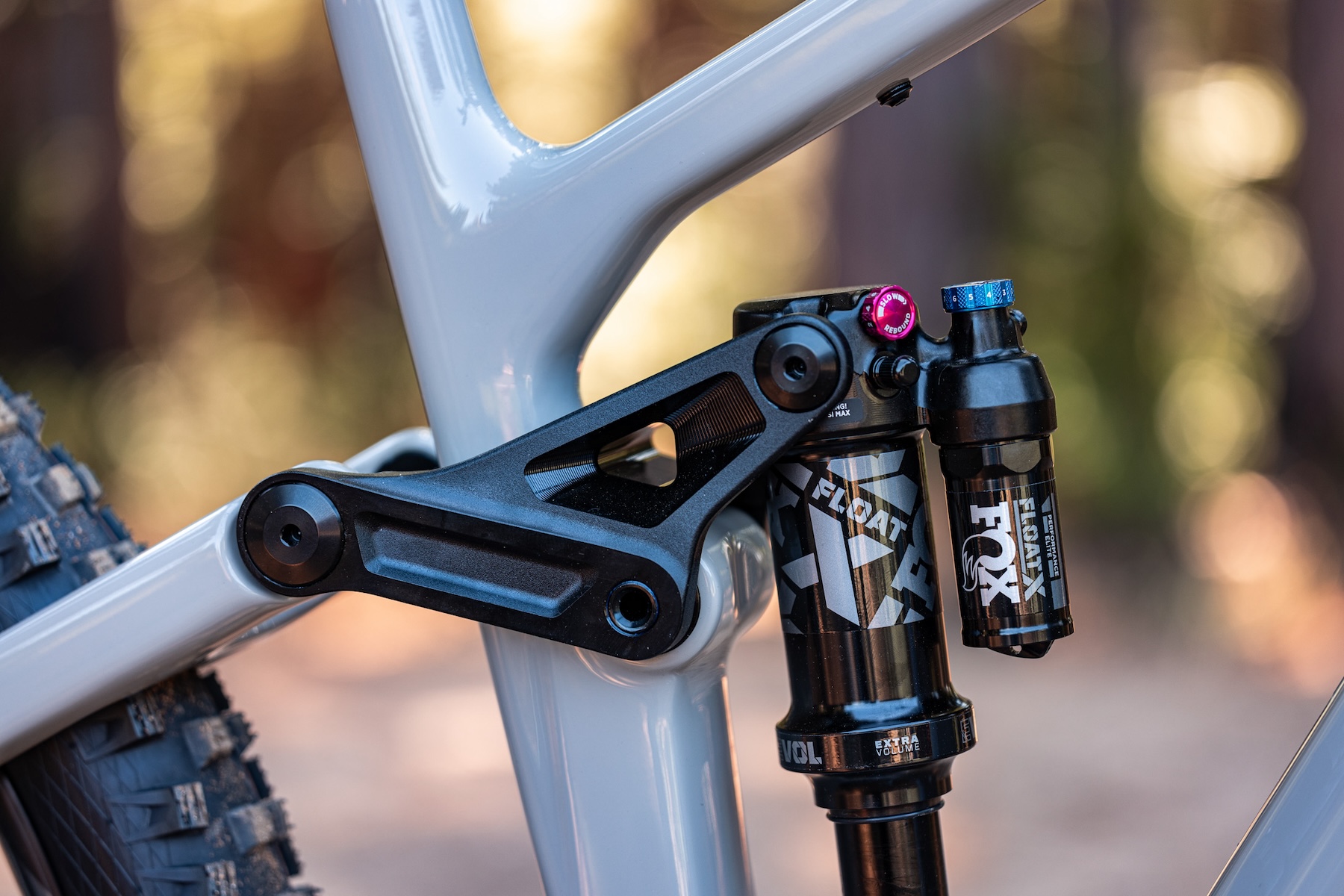
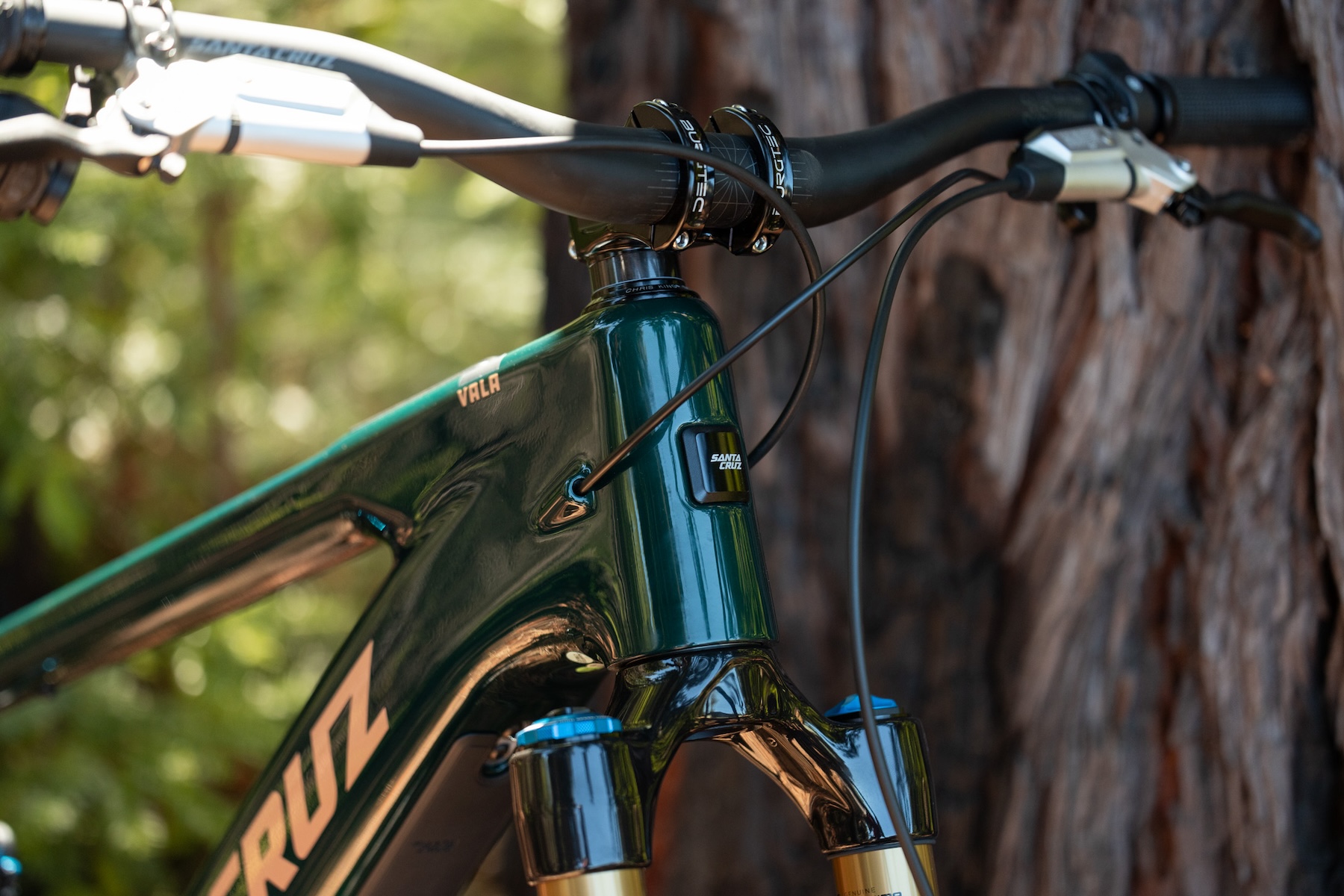
Suspension kinematics charts tell a clearer story. The Vala’s anti-squat is far lower and the curve is more linear than on the Heckler 9 and Heckler SL, which should offer more active suspension while reducing pedal kickback. Anti-rise also looks far different compared to the Heckler 9 — again lower with a more linear curve — for more active suspension under braking. The leverage ratio has been decreased on the Vala thanks to using a longer 60 mm stroke shock (compared to 55 mm on the Heckler 9 and Heckler SL), and a flip chip a the lower shock mount allows riders to choose between a low progression setting (26%) or high progression setting (29%). All of these details are included in the following charts:
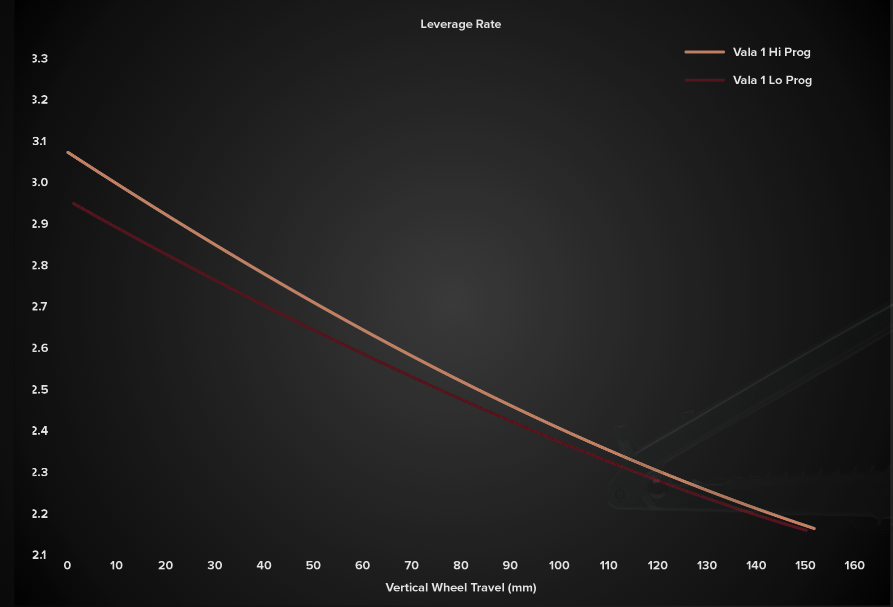
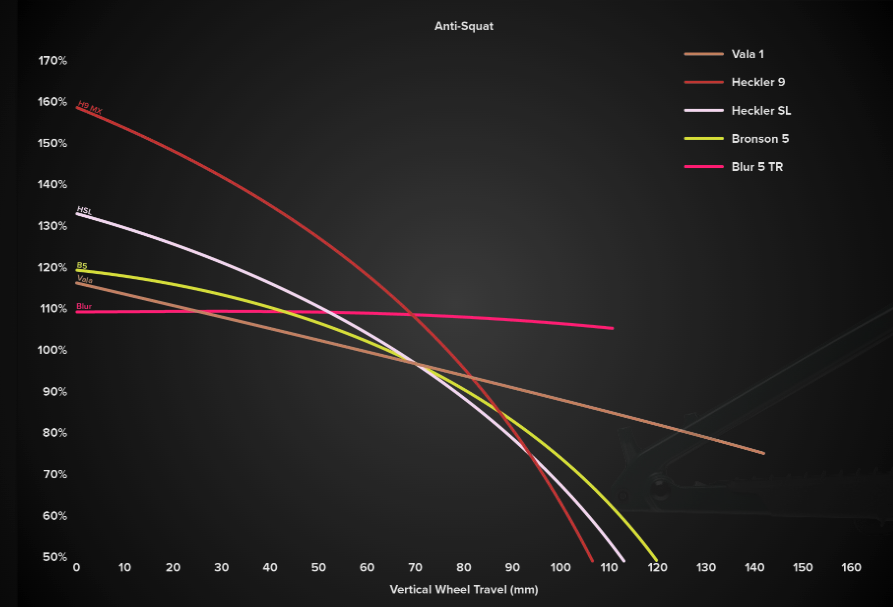
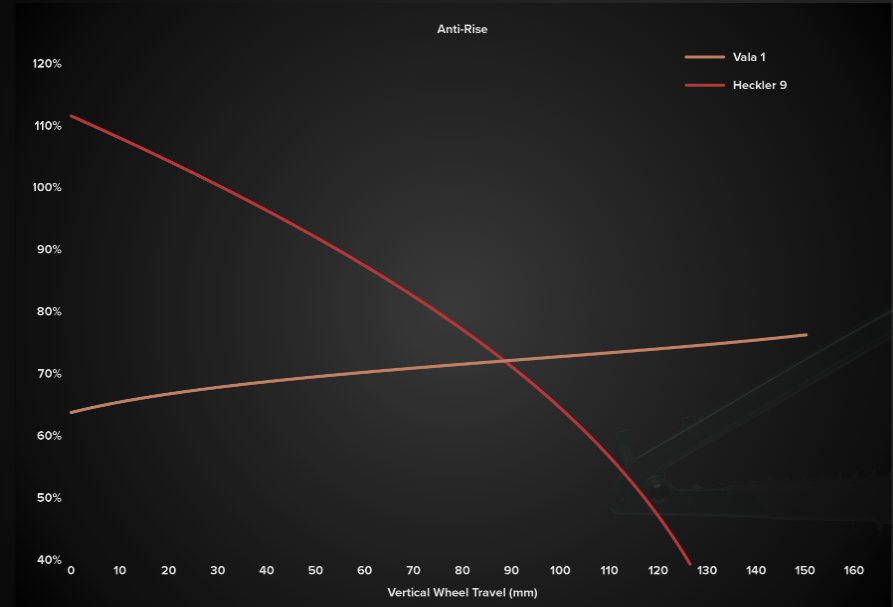
The shock is driven by a one piece upper link, and a seatstay bridge just behind the link improves frame stiffness for the added weight of an eMTB.
Santa Cruz has a bit of a reputation for particularly robust frame hardware and pivot designs, and that holds true with the Vala. The main upper and lower pivots use locking collet axles to keep things secure, and all pivot hardware uses a 5 mm allen key. The threads at the lower shock mount and chainstay and seatstay pivots are all replaceable to prevent potential frame damage, and an axle at the seatstay pivots holds all hardware captive so that the pivots can be disassembled without washers and small parts being dropped.
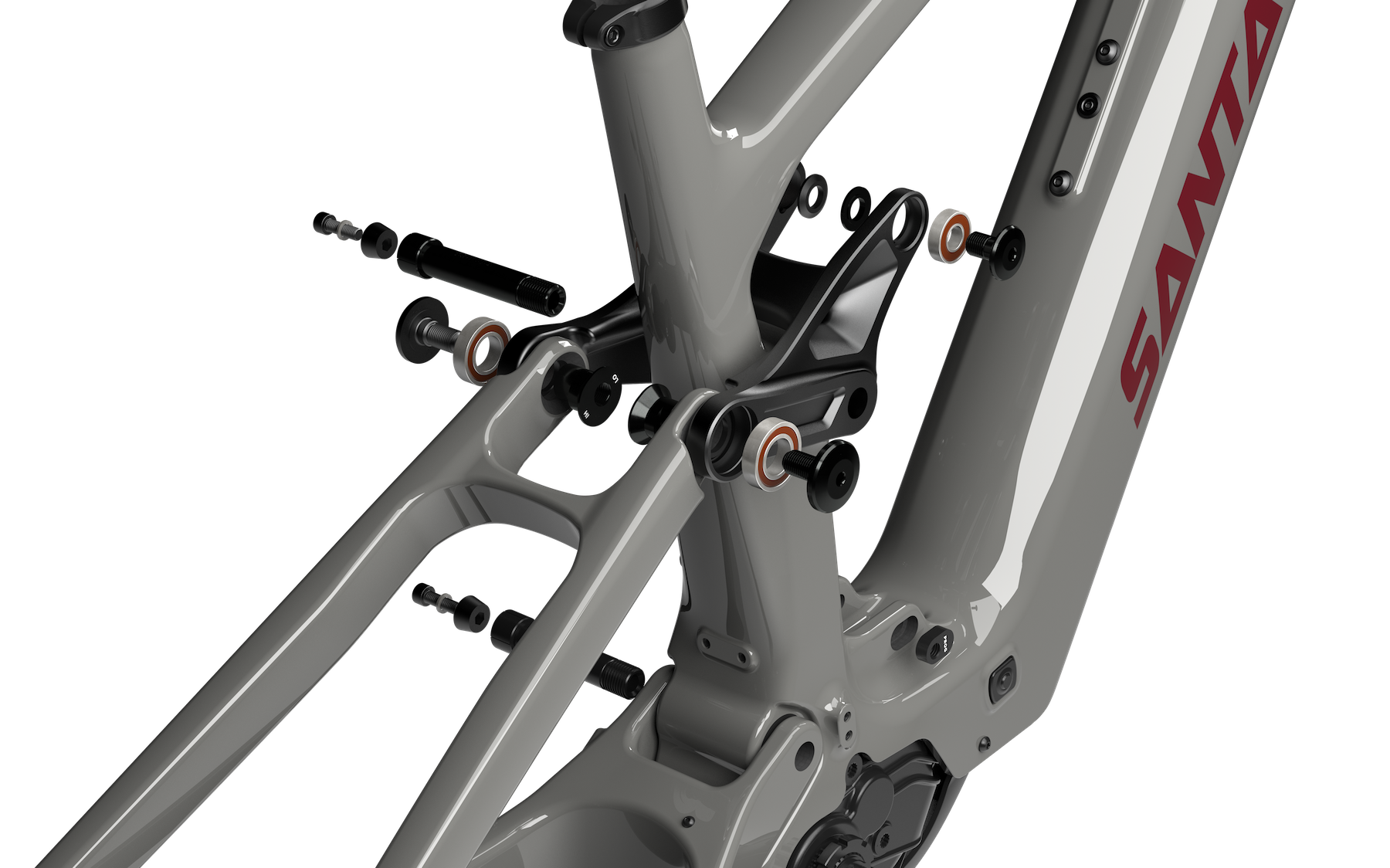
The simpler shapes of the Vala’s frame afforded by the new four bar design also allow for more seatpost insertion depth relative to the VPP-equipped Heckler — 110 mm more, to be exact. And while the inclusion of a battery eliminates any chance of downtube storage, there are still accessory mounts under the top tube.
As a final point, the Vala frames come in Santa Cruz’s C and CC carbon designations, with the higher-end CC construction used on only the two top end builds. The inclusion of mechanical shifting on the two lowest spec builds implies that the C frame still has a routing for traditional cable and housing, though we will need to confirm if the CC frame follows the Bronson and Hightower in being electronic-only without internal routing ports.
Drive System
The Vala’s drive system is the latest Bosch’s Performance Line CX motor, which claims to be quieter, lighter, and smaller than before. We’ve spent extensive amounts of time on the earlier versions of this motor and have been very impressed with its performance, so it’s a welcome sight on the Vala. Bosch’s familiar display is nested in the Vala’s top tube, which connects wirelessly to the mode switch on the handlebars
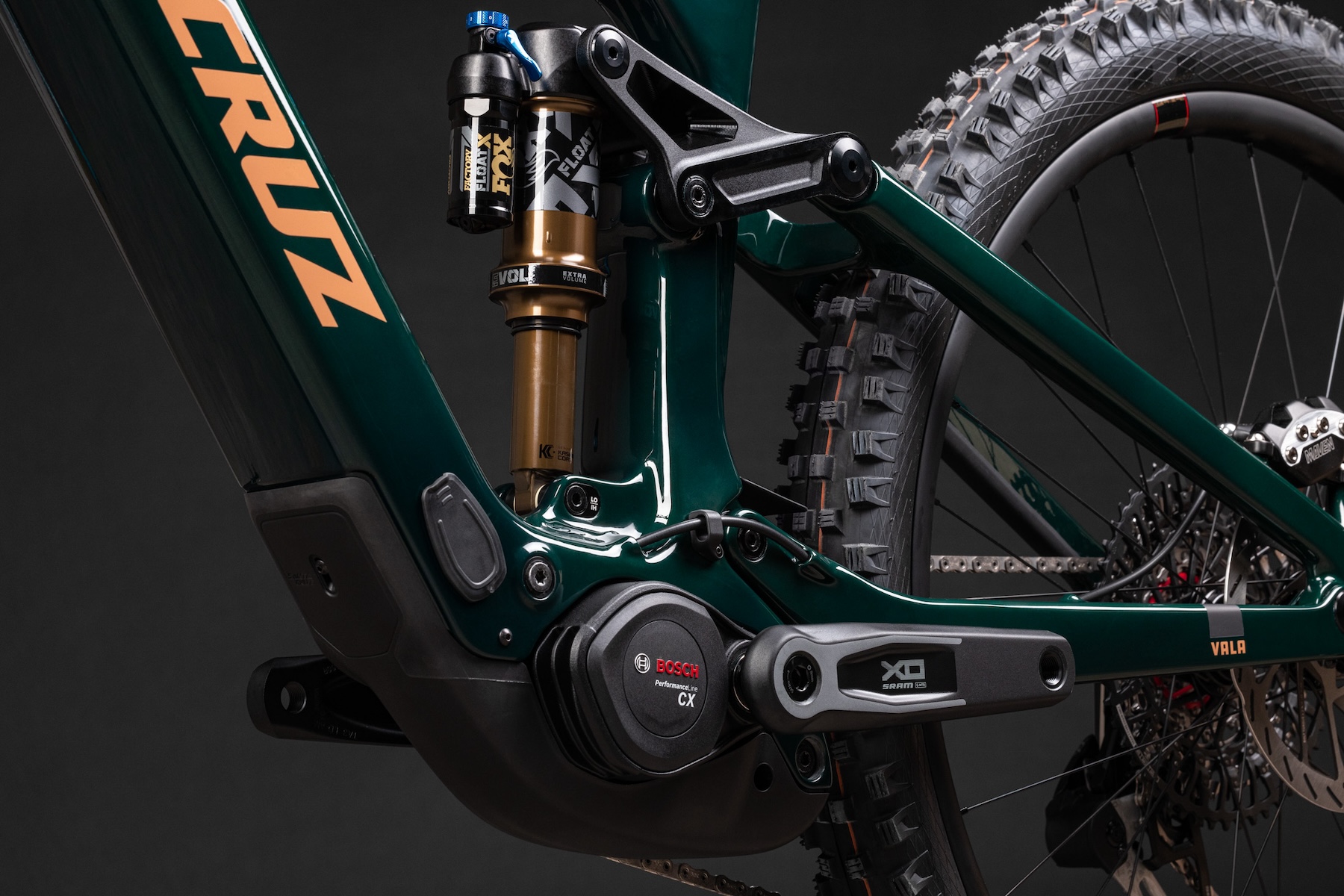
The Bosch battery has 600 Wh capacity, which is perhaps a bit smaller than we expected given that a number of newer full power bikes are now packing 700+ Wh. Santa Cruz’s rationale for using this smaller battery makes a lot of sense though — for one, the 600 Wh battery is a full 2.2 lbs / 1 kg lighter than the next size up (800 Wh). The battery is also physically smaller, allowing designers more room while also helping to keep the weight sitting lower in the frame.
Of course, 600 Wh will of course provoke some range anxiety amongst some riders. For those folks, Santa Cruz offers a 250 Wh PowerMore range extender, which takes the place of a water bottle, providing a very large 850 Wh total capacity.
Fit & Geometry
Despite being an eMTB, the Vala sits in the same 150 mm rear travel bracket as the recently released Bronson and Hightower. Perhaps it’s unsurprising, then, to see some very similar geometry numbers.
In High mode, a Large Vala has a 480 mm reach, 641 mm stack, 64.2° headtube angle, 344 mm bottom bracket height, and 443 mm chainstays. Dropping to Low mode has some fairly subtle changes, with a 477 mm reach, 644 mm stack, 63.9° headtube angle, 340 mm bottom bracket height, and 444 mm chainstays. Chainstay lengths do vary slightly by frame size, maxing out at 451 mm on the XXL frame.
Flip chip adjustments are made at the rocker link and seatstay junction, and that hardware is captive to allow adjustment without fully disassembling the pivots.
Full geometry figures are as follows:
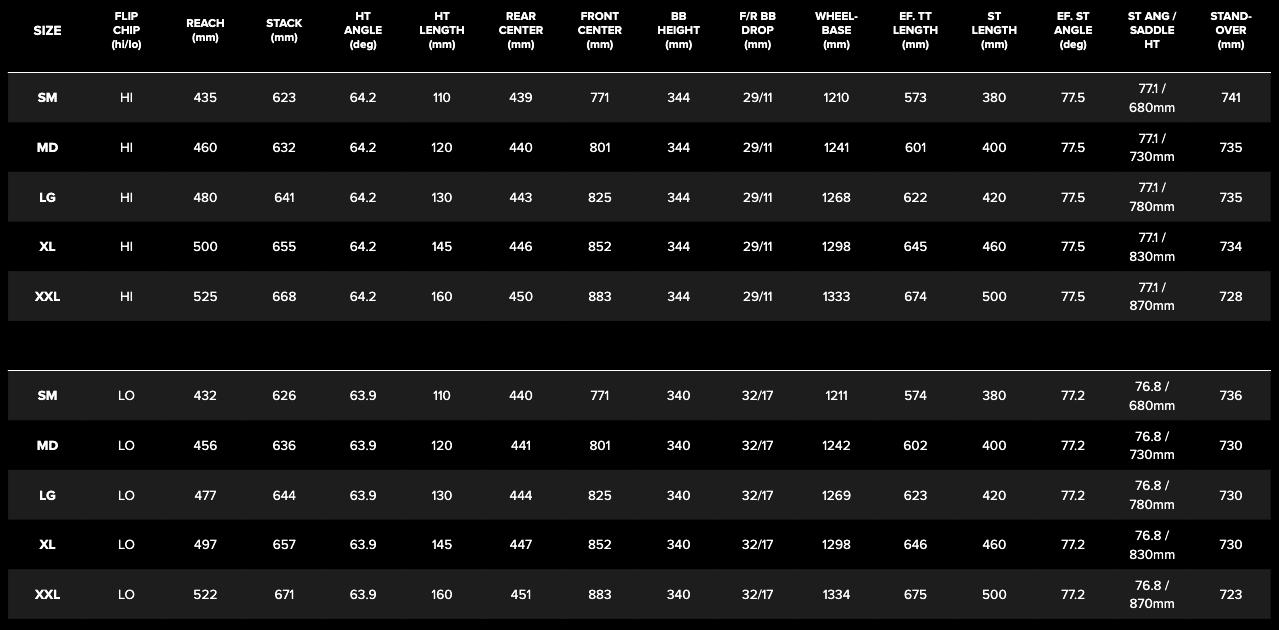
The Builds
Santa Cruz offers five build options with the Vala. The top four builds all get Fox suspension and SRAM Maven brakes with 200 mm rotors, in addition to shifting from SRAM. Only the base R build is an outlier here, getting a RockShox Zeb Base fork and SRAM DB8 brakes.
The Vala is the first complete bike we’ve seen to come with Schwalbe’s Magic Mary tires in the new radial casing option. For those unfamiliar, Schwalbe claims that the new casing design re-aligns the threads in the casing material to provide a significantly more compliant-feeling casing while still offering good puncture resistance.
[We’ve started spending time on the new Schwalbe Albert tires in the new radial construction. Much more on those coming soon.]
Santa Cruz also varies dropper post lengths by size, with the R build getting an SDG Tellis while all others get the OneUp V3. Santa Cruz says a size Large comes with a 210 mm post, and we always applaud brands who maximize dropper post length for a given size.
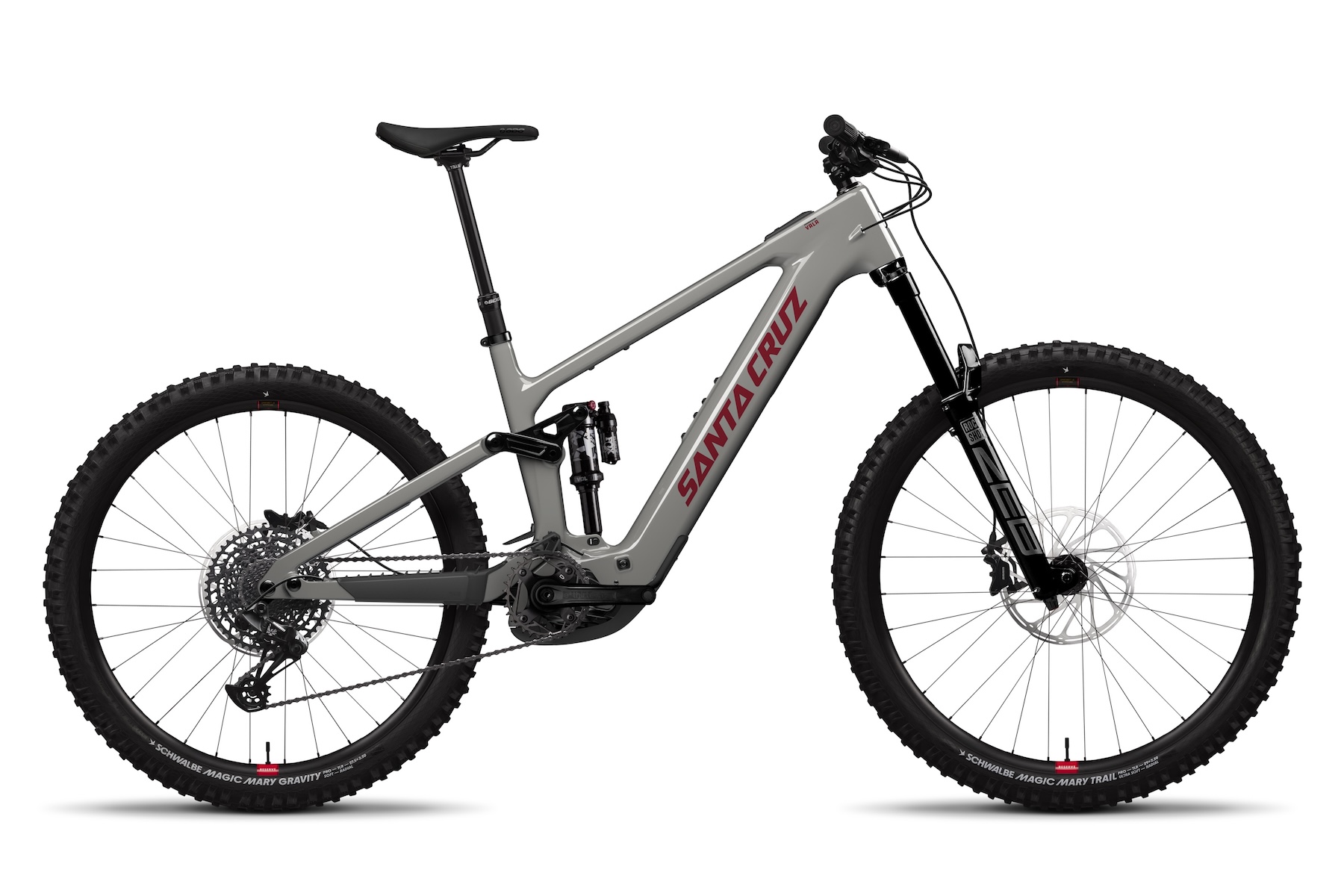
Full build details are as follows:
- Drivetrain: SRAM NX
- Brakes: SRAM DB8 (220 mm front rotor / 200 mm rear)
- Fork: RockShox Zeb Base (160 mm)
- Shock: Fox Float X Performance
- Wheels: Reserve 30HD AL rims / SRAM MTH 716/746 hubs
- Dropper Post: SDH Tellis
- Drivetrain: SRAM GX
- Brakes: SRAM Maven Bronze (200 mm rotors)
- Fork: Fox 38 Performance (160 mm)
- Shock: Fox Float X Performance
- Wheels: RaceFace ARC 30 HD rims / e13 SL E-Spec hubs
- Dropper Post: OneUp V3
- Drivetrain: SRAM GX Transmission
- Brakes: SRAM Maven Bronze (200 mm rotors)
- Fork: Fox 38 Performance Elite (160 mm)
- Shock: Fox Float X Performance Elite
- Wheels: RaceFace ARC 30 HD rims / e13 SL E-Spec hubs
- Dropper Post: OneUp V3
- Drivetrain: SRAM XO Transmission
- Brakes: SRAM Maven Silver (200 mm rotors)
- Fork: Fox 38 Factory (160 mm)
- Shock: Fox Float X Factory
- Wheels: Reserve 30HD Carbon front, 31DH rear rims / DT Swiss 350 hubs
- Dropper Post: OneUp V3
- Drivetrain: SRAM XX Transmission
- Brakes: SRAM Maven Ultimate (200 mm rotors)
- Fork: Fox 38 Factory (160 mm)
- Shock: Fox Float X Factory
- Wheels: Reserve 30HD Carbon front, 31DH rear rims / Industry Nine Hydra hubs
- Dropper Post: OneUp V3
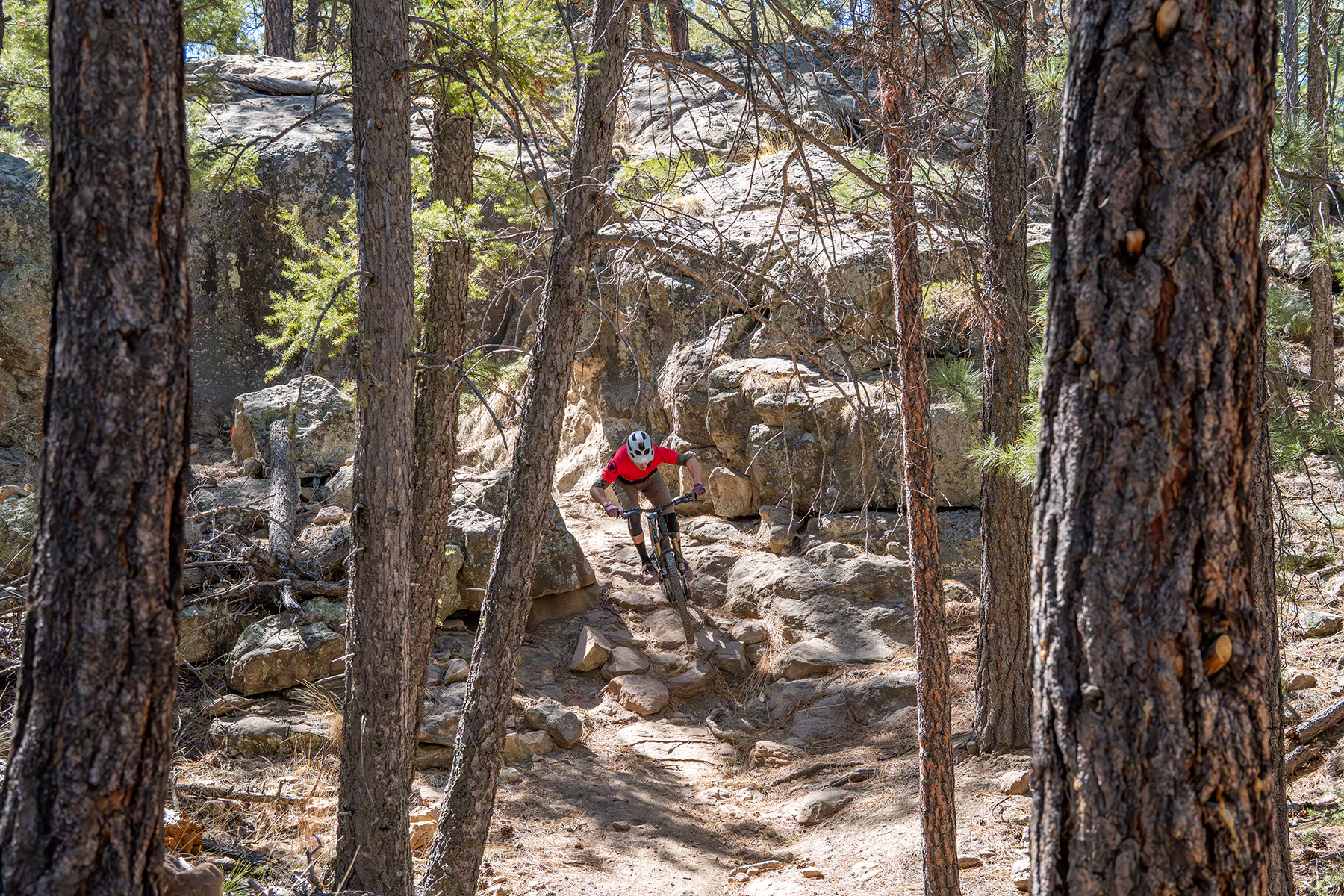
Full Review
Santa Cruz threw a curveball when they launched the Vala: no one was expecting an entirely new suspension platform from the brand so well known for VPP bikes. But in hindsight, it isn’t such a surprise, given the challenges of packaging the lower VPP link with a full-power eMTB drive system. They pulled it off with the first-generation Bullit and Heckler, but compromises had to be made.
It couldn’t have been easy to abandon a suspension design so synonymous with their brand, but Santa Cruz acknowledged the limitations of combining their preferred lower-link-driven VPP suspension with an eMTB drive system, and the Vala’s Horst link layout is the result.
With the introduction of the Vala, Santa Cruz is jumping into one of the most competitive spaces in the broader eMTB landscape — the mid-travel Trail category. It’s time to see how Santa Cruz’s all-new, ground-up eMTB fares.
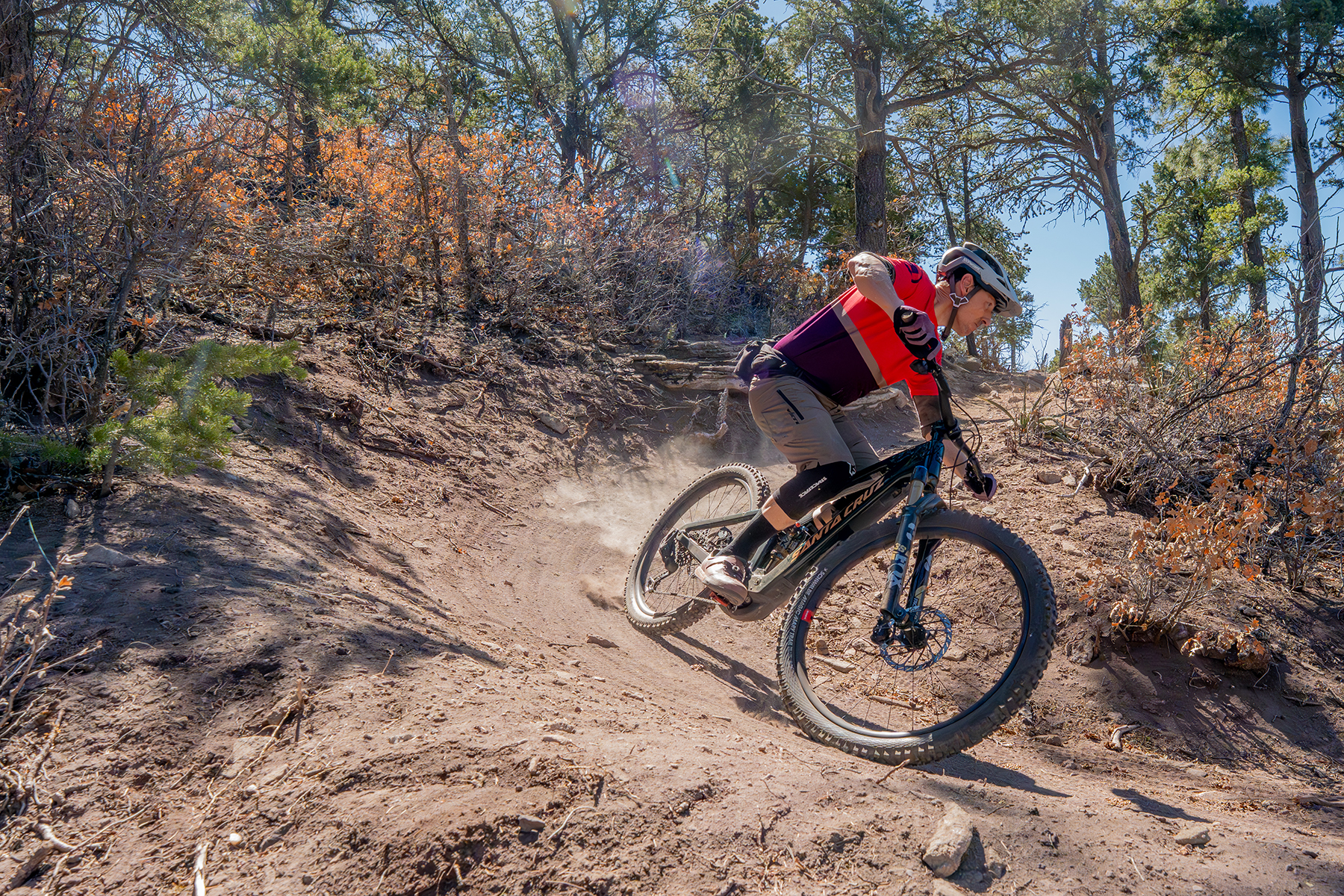
Fit & Sizing
Simon Stewart (6’, 170 lbs / 183 cm, 77 kg): Out of the box, the Large Vala was about as perfect a fit as it gets for me. That wasn’t a huge surprise, given that the Vala’s geometry is almost identical to that of the Large Heckler SL (more on that in a minute), which was an excellent fit for me.
That said, one area of the Heckler SL’s geometry that I thought could use a tiny bit of improvement was the stack height: I found it to be on the low side for my hand position preference. Perhaps Santa Cruz was listening because they added 10 mm to the head tube of the Vala in comparison to the Heckler SL. The longer head tube increases the stack height by 8 mm, raising it to 641 mm for the Vala in the “Lo” geometry position — a welcome increase. The stack height decreases by 2 mm when going from the “Lo” geometry setting to the “Hi” setting, and since I found the fit to be so spot on in the “Lo” setting, I opted to swap a 2.5 mm headset spacer from above the stem to below it when changing to the “Hi” geometry setting.
One of the reasons the Vala is such a good fit for me is the 480 / 477 mm (Hi / Lo) reach, which is right in the middle of my preferred range. And thanks to the 644 mm stack height, I didn’t need to swap stems or handlebars to dial in the cockpit. The 77.2º seat tube angle is plenty steep without being overly so, as I find they start to feel when getting into the mid-78º and higher range. The reach and effective top tube numbers change slightly with the geometry flip chip, but not enough to make it fit drastically differently. I have ample room to move my body position around in both geometry settings.
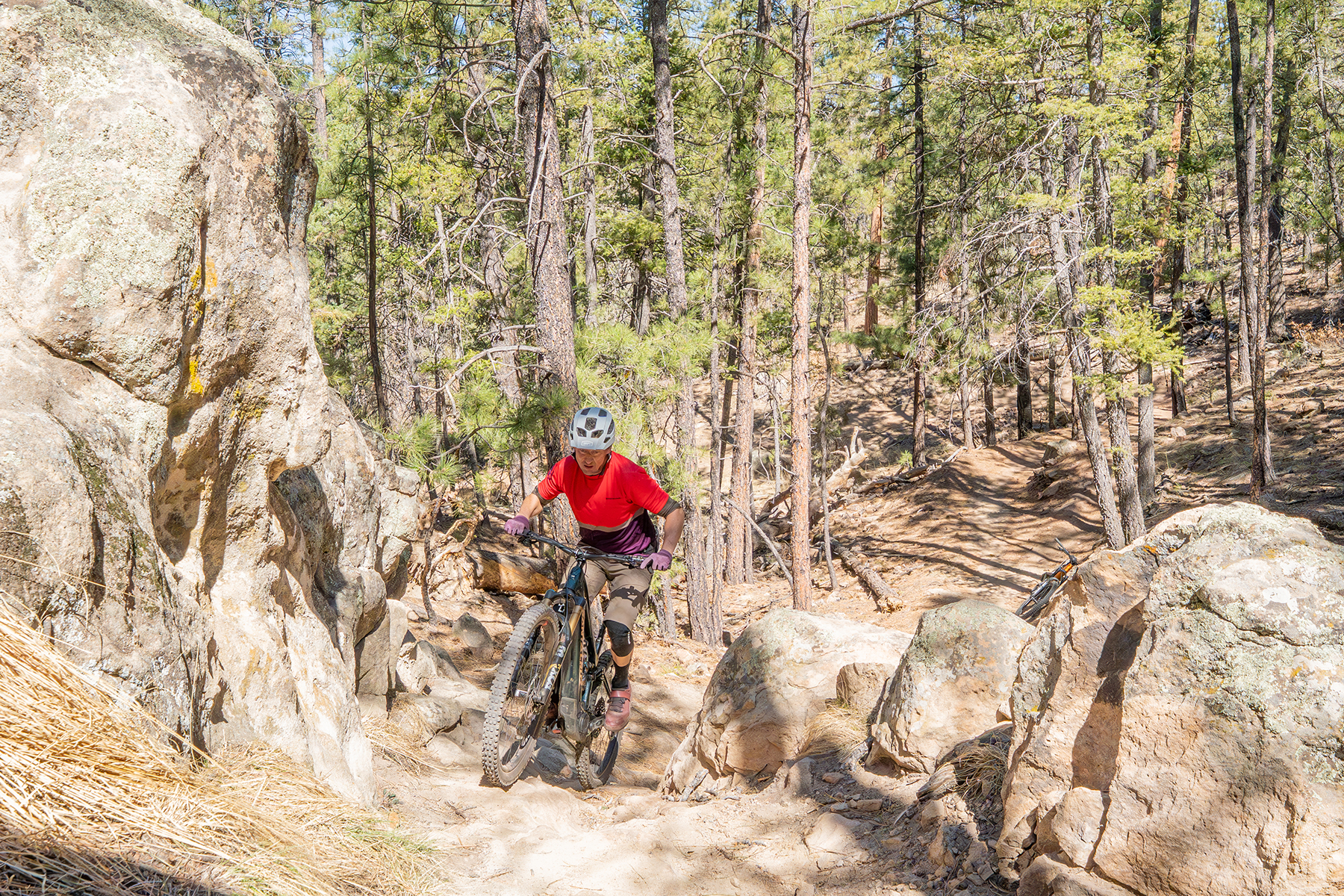
Climbing
Evaluating eMTB climbing performance is quite a bit different than how we approach it on non-powered bikes. Pedaling efficiency — one of the hallmarks of a good climbing mountain bike — is pretty much off the table. For that reason, I use steep technical climbs as benchmarks — a few of which I have little chance of actually cleaning — so how far up the bike makes it is often a useful metric. One of my favorites is a steep, technical moto trail that has multiple benchmark sections, with each presenting a unique challenge. Putting together a clean bottom-to-top run had eluded me, and I’ve tried many times on every full-power eMTB that I’ve tested.
Thankfully, we’ve had some warm weather, and the snow just melted off, leaving the trail in prime condition to give the Vala a go, right before having to box it up and send it home to Santa Cruz. Good thing I did because the Vala laid down a clean run and now has the distinction of being the only eMTB on which I’ve been able to stitch together all the benchmark sections in one continuous, dab-free session. Consider me very impressed, and it’s not like I was having a particularly good day — it’s a bit early in the season to be in good form for that kind of physically demanding trail.
So, let’s dig into how I think the Vala did it. The first thing that comes to mind is traction. I don’t remember it breaking traction once, which is quite revealing given the loose, blown-out conditions (typical for a moto trail in my area). Confidence in a bike’s ability to put down power has a compounding effect, and each time you expect to lose traction and don’t, that confidence builds. Then, when faced with high-consequence sections where committing to a line is often the make-or-break moment, you go for it without hesitation, like I repeatedly did on the Vala.
I was so impressed with the Vala’s traction that I started to consider other variables that might have been contributing. The Vala comes spec’d with Schwalbe’s new Magic Mary radial tires (more on those in the Build section), which is my first experience with them. Some of my first impressions were that they have incredible traction, but since they feel different than what I’m used to, I decided to swap them out with tires I’m more familiar with for testing purposes. I threw on a Maxxis Assagai (3C MaxxGrip) in the front and a Minion DHR (3C MaxxTerra) in the rear. After a few rides on the Vala with the Maxxis tire setup, I think the Schwalbes do have a touch better pedaling traction in loose-over-hard conditions, but it’s not game-changing, so the Vala deserves the majority of credit for how well it puts power down.
What we’re left with is the Vala being one of the best technical climbers we’ve tested. The suspension is traction-rich while also staying nicely composed on bigger ledge moves that require substantial weight shifts. The CX motor’s overrun (Bosch refers to it as extended boost) is lovely in the way it keeps supplying power after you stop pedaling and made easy work of powered front wheel lifts up some pretty big ledges. I often found myself using half pedal strokes to keep the assist going through tricky tight sections where a full revolution of the cranks was not possible, again made possible by Bosch’s extended boost functionality.
Of the two geometry settings (Hi or Lo), there isn’t a huge difference between them when climbing, but I did notice a hair more steering precision and slightly less wandering on steep pitches in the high setting. There is only 0.3º between the two settings, with the head tube angle either 64.2º or 63.9º. In both settings, I feel nicely centered and find the seated climbing position to be plenty comfortable. In the Low setting, there’s a little more rearward weight bias that makes it easier to pick the front end over ledges and other trail obstacles. I don’t have a clear favorite between the two settings when climbing, as I do when descending, mostly because the differences are quite subtle.
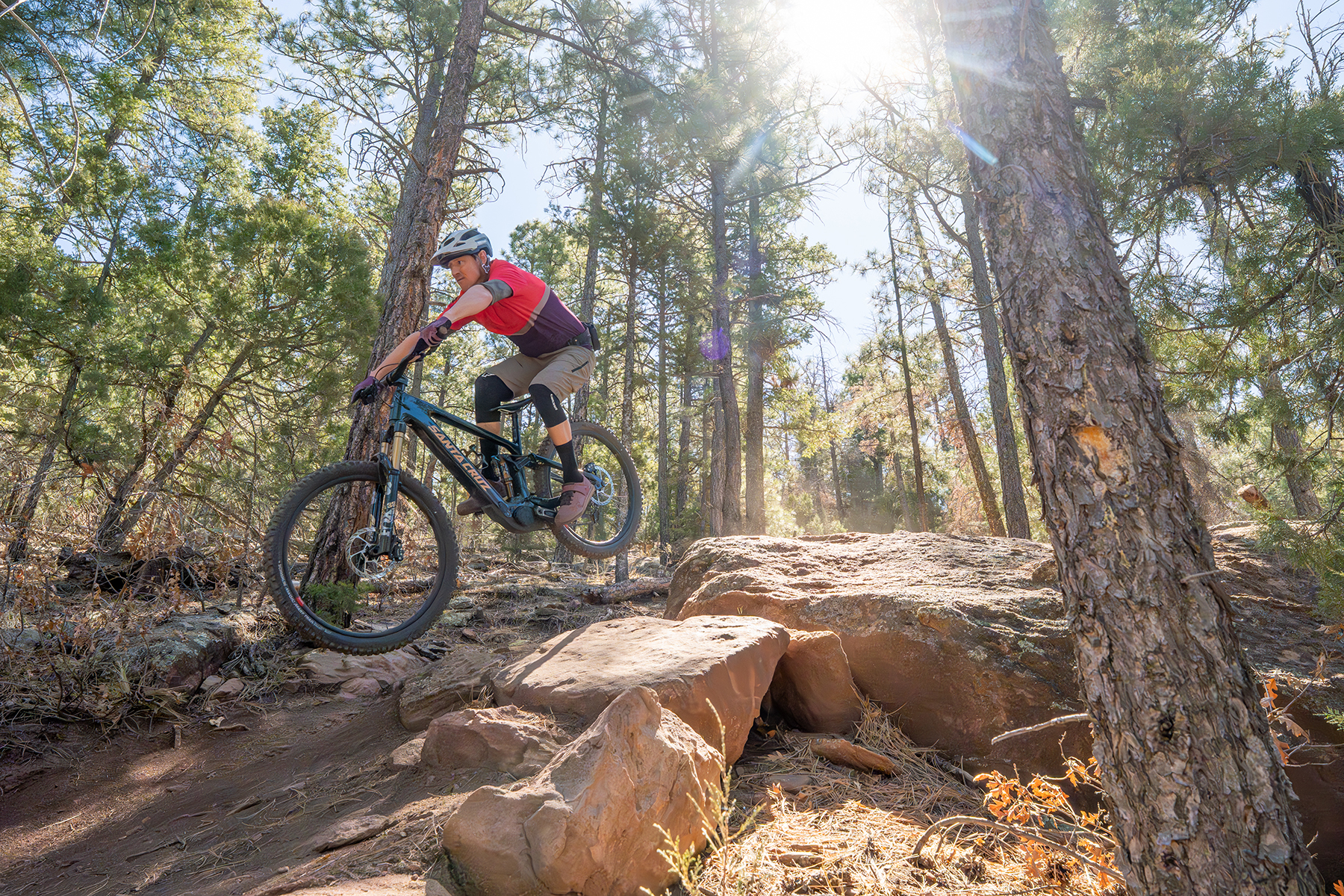
Descending
With 150 mm of rear travel from an entirely new (for Santa Cruz) suspension platform, we weren’t sure what to expect from the Vala when going downhill. It would make sense that it would have a lot in common with the Bronson 5 since they share almost identical geometry and build specs, but the novel rear suspension made us reluctant to make any assumptions. Plus, the suspension kinematic graphs point to a more active suspension when pedaling and braking than Santa Cruz’s other eMTBs with VPP suspension platforms like the Heckler and Heckler SL, due to lower anti-squat and anti-rise.
I didn’t get the chance to ride a Heckler, but I have a ton of miles on the Heckler SL. One of the first things I noticed about the Vala is how active the suspension feels in comparison to the Heckler SL, and on the non-motorized side, the Bronson 5. Historically, I’ve found a lot of Santa Cruz bikes to be more playful than game-on speed-focused race bikes, which is especially true for the Heckler SL and Bronson 5. Despite having a more active suspension, the Vala retains the playful personality we’ve come to expect from Santa Cruz bikes.
As I mentioned in the Climbing section, I prefer the “Lo” setting when descending. The slightly more rearward weight bias makes the Vala a lot of fun to power manual (using the motor’s overrun to get the front end up), and the slacker head angle feels more confidence-inspiring on steep rock slab rolls. At first, I was a bit torn because, in the high position (64.2º), I was getting tons of grip from the front wheel, leading to some pretty fantastic oversteer. When switching to the “Lo” position (63.9º), I initially wasn’t getting the back end to step out as much, but after adjusting my body to a more forward position, it started to come back. The Vala is an incredibly fun cornering machine — it encourages you to look for corners to slash and is super rewarding when you do.
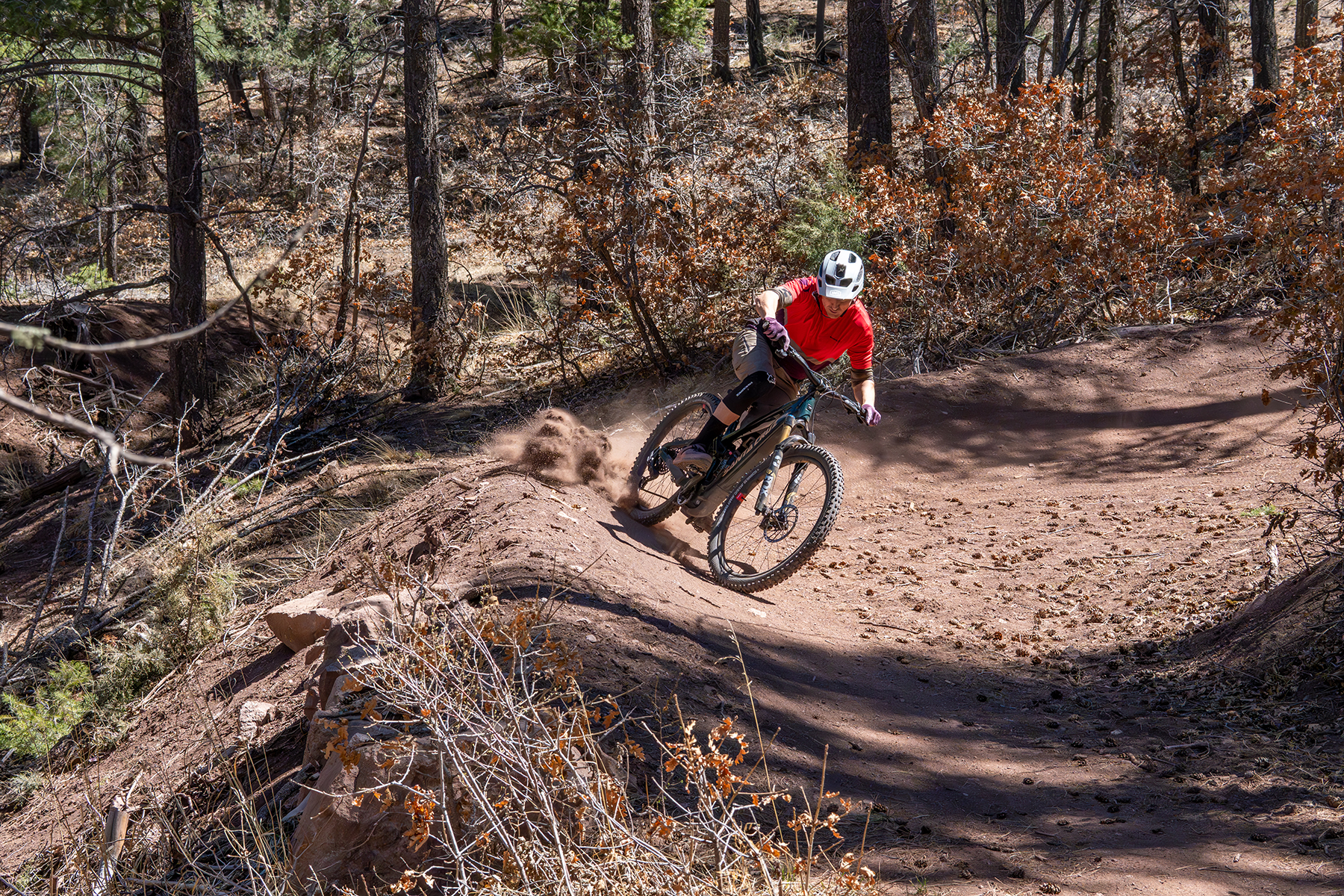
Interestingly, despite the Vala having tons of traction when climbing, it’s so quick to let the back end get loose in corners. It may seem like those traits contradict each other a bit, but it really works for the Vala. In fact, it’s one of the things I like most about the Vala’s handling. I think the mullet rear end has a lot to do with it, along with the active suspension being so adept at putting power down. The Vala makes a strong case for me being team mullet for eMTBs — I’ve kind of oscillated back and forth on mixed-wheel size setups, but I think I’m leaning towards that being my general preference for eMTBs again.
I spent some time taking the Vala down some flow and jump trails. These kinds of trails are often challenging on full-power eMTBs because the motor cutoff is 20 mph, and the trail speed necessary to hit all the transitions is often higher than that. Getting a full-power eMTB past 20 mph takes a herculean effort, so you often end up casing the first jumps, and the whole run is typically blown after that. I’m not suggesting the Vala was like a non-powered bike here, but its sub-47 lb weight was noticeable when pushing past the motor cutoff, and I was able to hit transitions I’ve missed on other heavier eMTBs.
In addition to the geometry flip chip, the Vala also has a shock rate flip chip at the lower shock mount. I spent the majority of time in the “Hi” setting, with 29% progression. I experimented with the Low 26% progression setting but found I prefer the slightly better small bump compliance in the “Hi” setting. The “Lo” position did make the Vala a touch more supportive at the beginning of the stroke, but for an eMTB, I’m not sure what benefit that has, since more support typically helps increase pedaling efficiency during that part of the shock stroke. I was thinking it may make it a little more lively, but I wasn’t able to detect any change there — the difference in the shock rate between the two settings is quite small, so tangible differences aren’t super apparent.
In more rough fall-line type descents, like going back down from the benchmark climb I mentioned in the Climbing section, the Vala stays on the chosen line well without getting too bucked around. It’s not the most stable bike I’ve ridden down that trail (that was the Orbea Wild), but for a mid-travel Trail eMTB, it does pretty well in the stability department. Being a mullet, Santa Cruz likely could have packaged shorter chainstays had they wanted to, but I think the 443 mm chainstays they settled on for the size Large Vala (the chainstays are size-specific) offer a nice compromise of stability and agility while also not taking away from its underlying playful personality.
On high-speed descents, the lower weight of the smaller 600 Wh battery in the downtube is noticeable when you need to get the front end up quickly to clear obstacles without assistance from the motor. Having the geometry flip chip in the “Lo” position is also beneficial here too, since it creates a slightly more rearward weight bias and takes less movement to unweight the front end.
Overall, the Vala’s new Horst link suspension is impressive; it’s very active with good sensitivity and an energetic, playful feel, plus ample bottom-out control — I didn’t experience any harsh bottom-outs.
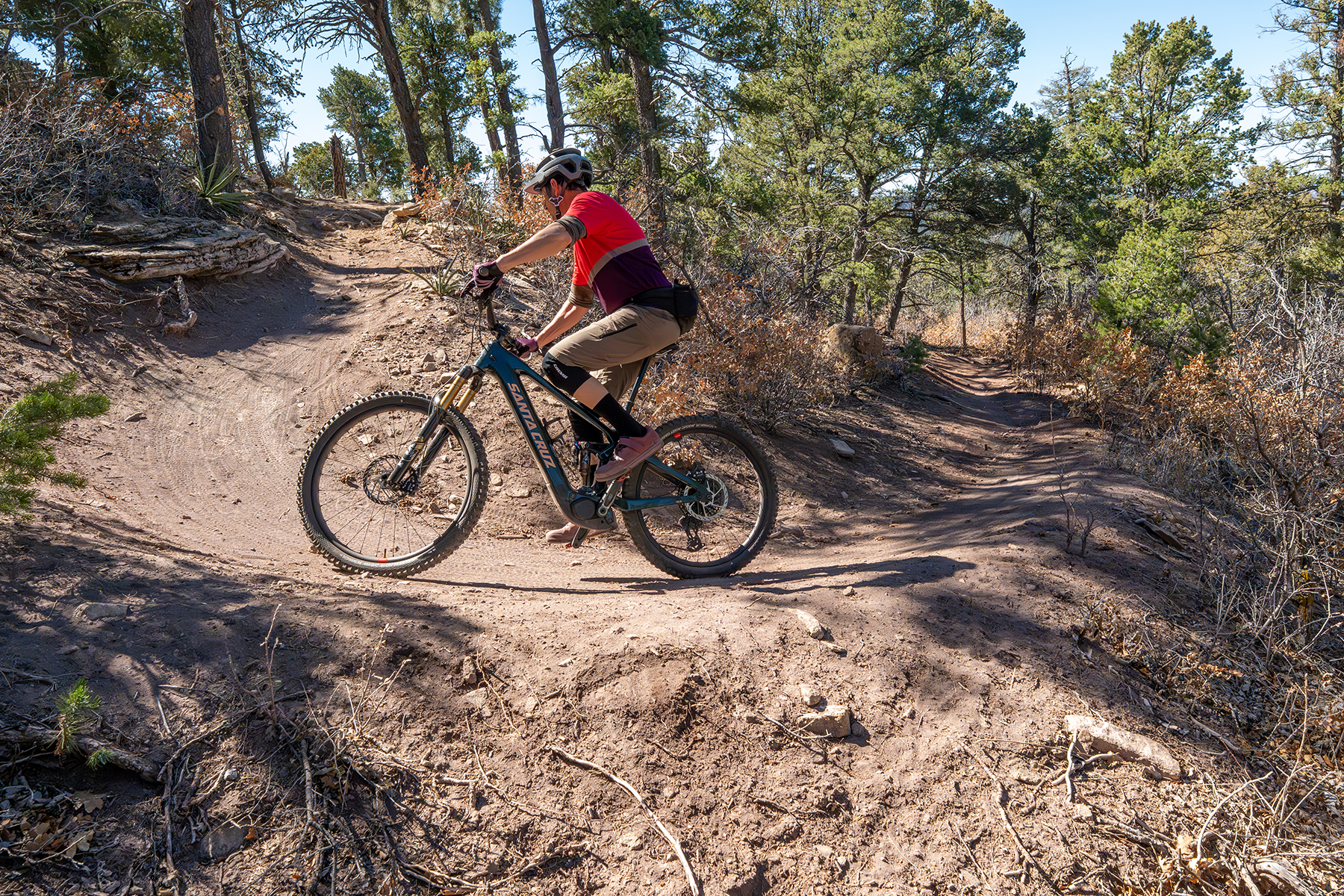
Drive System and Range
The Gen 4 Bosch CX Performance Line drive system was a favorite of mine, and the Gen 5 version in the Vala has cemented its position. We go into detail on all the changes Bosch made to improve one of the best drive systems on the market, in addition to our early impressions in our Flash Review. Here, we’ll get into a more long-term on-trail report.
As we get into in the Flash Review, Bosch left the power numbers alone in their latest update, which at the time, I’m sure, seemed like the right direction. The Gen 4 CX motor had respectable numbers with 85 Nm of torque and 600 watts of peak power, so it makes sense to focus on refinements. But things move quickly in the eMTB space, and new drive systems from Specialized and DJI have come out with considerably higher numbers. To be clear, I find the power of the Gen 5 CX motor to be more than adequate, and I like that they focused on responsiveness, ride dynamics, reducing noise, and shaving off some weight. Would I turn down more power? Of course not, but like I said, I don’t find the power to be lacking. That opinion may change once I’ve spent time on the new Specialized Turbo Levo 4 we have on the way.
The new motor is unquestionably quieter than the outgoing version, and that noise reduction is one of the more noticeable improvements. Even when pushing the motor in the maximum assist mode (Turbo) up long climbs, the noise remains constant. Many motors, including the previous generation CX, get louder when they get hot under heavy, sustained loads. Additionally, the
power seems like it drops off somewhat proportionally to the increase in noise. The Gen 5 CX, on the other hand, not only remains more consistently quiet, but it also doesn’t suffer from as much heat-related power loss.
Because the new CX feels more stable and consistent under load, it comes across as having more power than the Gen 4 CX motor. Combine that with increased responsiveness, and the new CX motor just feels peppier everywhere.
Battery technology is arguably moving quicker than motors, and Bosch introduced two new batteries with the CX drive system update. Both batteries are lighter and more energy-dense than the ones they replace. Santa Cruz chose the smaller 600 Wh battery for the Vala, which has a major influence on the Vala’s very respectable sub-47-lb / 21.3 kg weight. The 600 Wh battery has proven to be a bit of an overachiever and has delivered better range than expected. With that said, I think a small battery (600 Wh or less) in a full-power eMTB only makes sense if a range extender is available. I’ve come to really appreciate the small battery / range extender combo because it offers the benefits of a lighter eMTB for most rides, and then there’s the option to add a range extender for the less frequent big adventure rides.
On the reliability side, we put around 400 miles on the Vala with zero issues from the drive system. There was a rattle that appeared on the last ride, but that turned out to just be loose battery mounting fasteners — an easy fix. In general, I think bolt checks should be done more regularly on eMTBs — there are more things to loosen up, and due to the higher speeds and weight, they take more abuse.
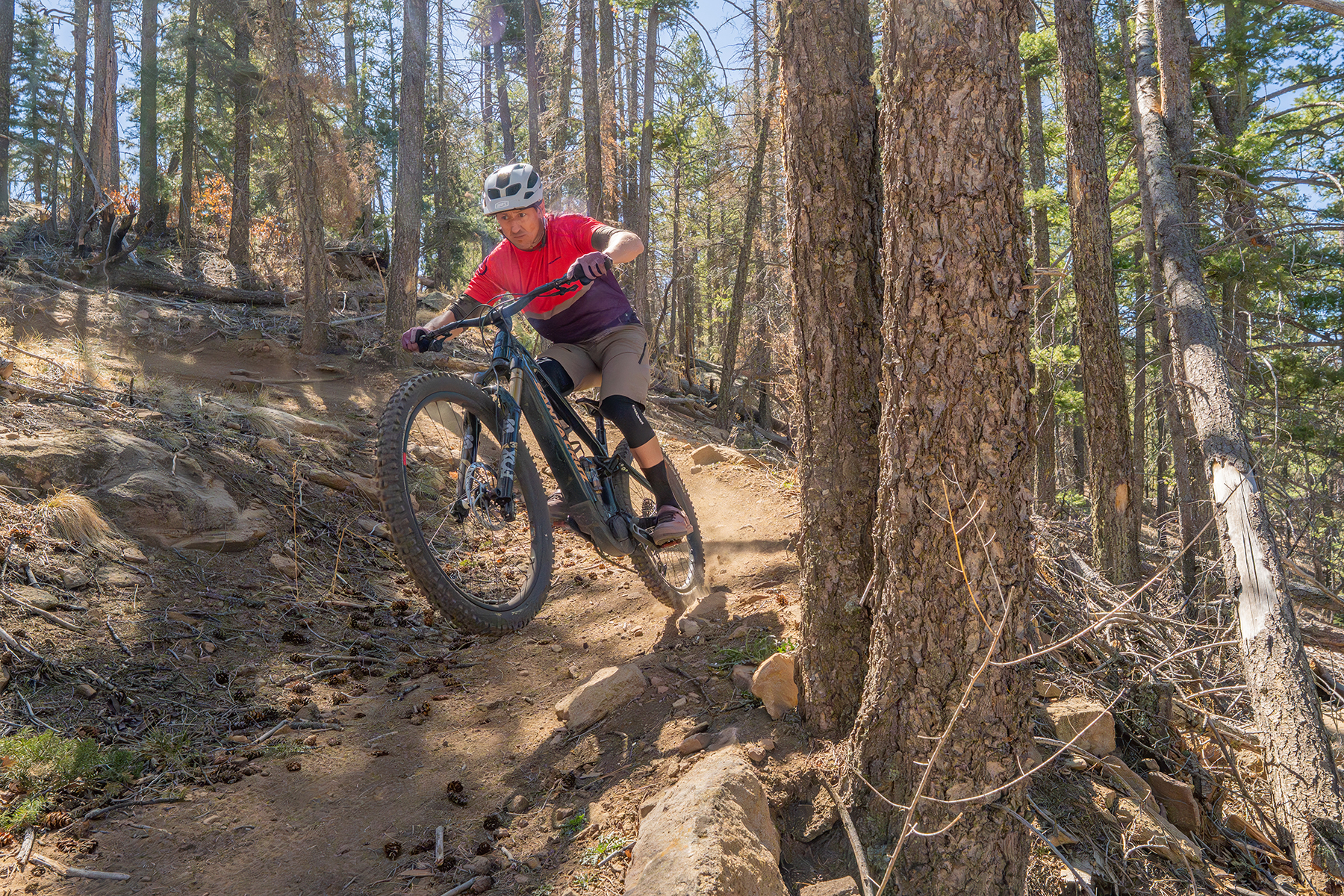
The Build
We received the Vala in the XO AXS Reserve build, one down from the top-spec XX AXS Reserve. There’s no hiding that it’s an expensive bike, but as to be expected, the spec leaves little in need of upgrading. Santa Cruz calls the color Midnight Green, but it looks a hell of a lot like British Racing Green to me — either way, I love it.
The SRAM Maven Silver brakes are a highlight and are now at the top of my list of powerful brakes suitable for heavy eMTBs. Even with the spec’d 200 mm rotor up front (there are 220 mm rotors available), I feel like the power is a massive upgrade over SRAM’s Code brakes. In addition to their insane power, they stay very consistent on long descents while doing the hard job of slowing down a nearly-47-lb / 21.3 kg bike. We go into more detail about the Mavens in our Full Review.
I’ve now had two review bikes with SRAM Maven brakes, and both of them have needed the rear brake bled out of the box. It’s not uncommon for an air bubble to be hiding in a brake system from the factory bleed, and after getting jostled around during shipping, or the first ride, that air bubble can move into a position that makes it more noticeable at the lever. However, David mentioned in his Full Review of the Mavens that he also experienced some bleed issues, which makes me wonder if the switch to mineral oil is making them a little fussier — let’s hope not.
Another highlight is Schwalbe’s Magic Mary tires with radial construction (in the Trail Pro Radial casing / Addix Ultra Soft compound for the front and the Gravity Pro Radial casing / Addix Soft compound for the rear ). They work exceptionally well in the mostly dry, loose conditions I tested the Vala in. They have good traction and predictable handling on edge. I routinely test bikes in some pretty rocky terrain, and I really like the supple trail feel the Magic Mary’s deliver because it takes a bit of the edge off. Check out our Flash Review of the Magic Mary radial tires for a more in-depth look.
Other component highlights include the OneUp dropper post, SRAM XO Transmission, Fox Factory suspension, and Santa Cruz Reserve wheels. Overall, I think Santa Cruz does a nice job spec’ing their bikes, and the XO AXS Reserve build is no exception — there’s nothing in the build that I would swap out.
Besides the drive system rattle that was easily remedied, the Vala has been quiet and smooth throughout its time with us. None of the pivots have come loose, and each time I checked them, I was thankful that all the pivot hardware uses a 5 mm hex to make things easy (the swingarm and upper link pivots use a 5 mm hex for the locking collets, with an 8 mm hex on the pivot axles). Santa Cruz also offers free bearing replacement to the original owner, and the frame carries a lifetime warranty.
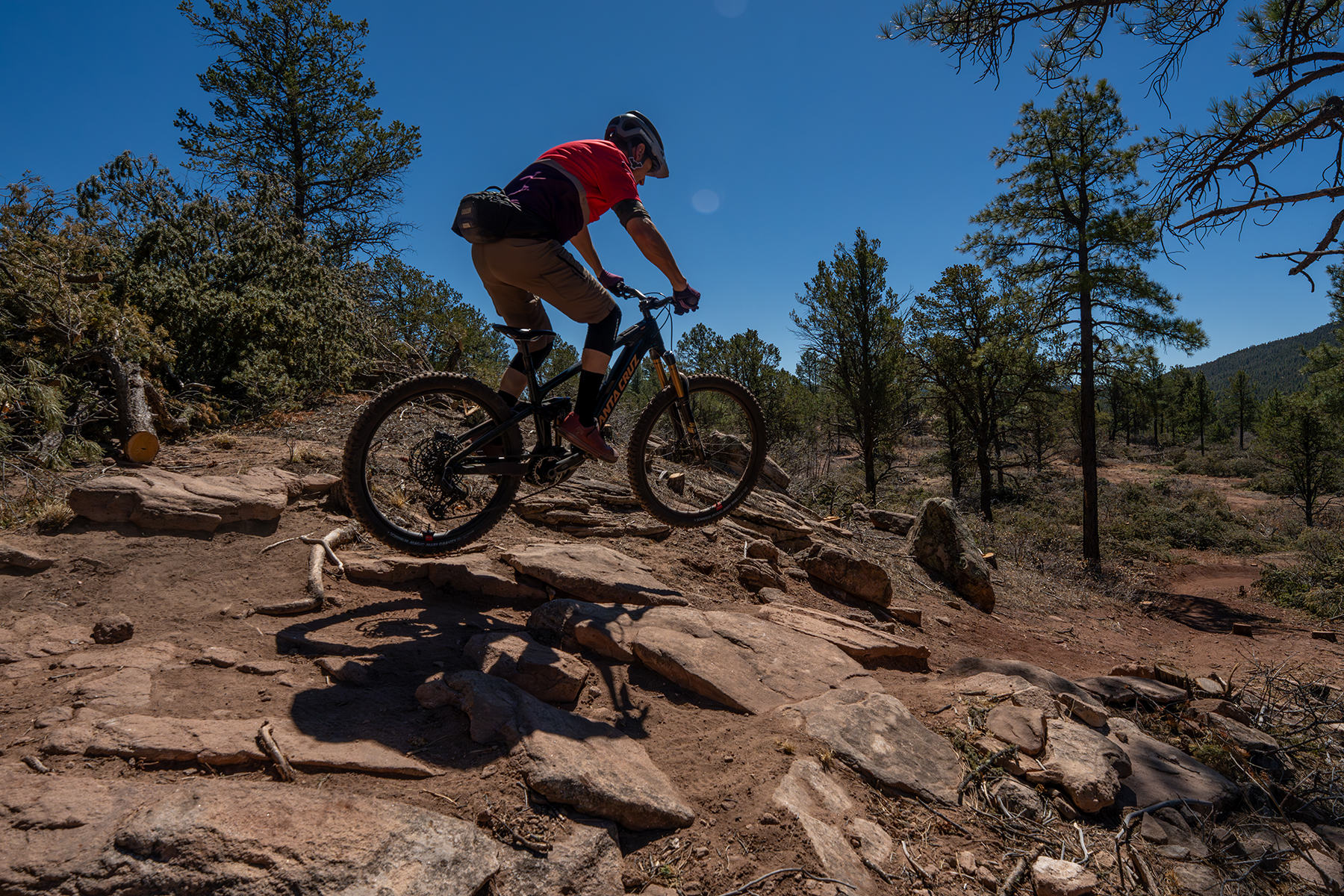
Who’s It For?
The Vala is a great option for riders who aren’t prioritizing maximum range and instead are more interested in a lighter-weight package in the Trail eMTB category without dropping down to a light assist bike. Santa Cruz’s decision to spec the smaller 600 Wh battery with the option to add a range extender is a tidy way to handle that in my book. On the one hand, it is a lightweight, natural-feeling eMTB that is well-suited for daily hot laps on your favorite trails; on the other hand, it can have 850 Wh of battery capacity to open up long adventure rides.
At under 47-Ib / 21.3 kg, the Vala is responsive and agile, with a lovely playful side that encourages the rider to seek out creative line choices. It’s not the best choice if you’re interested in an eMTB that focuses on flat-out speed; there are better options out there, but if you’re looking for an all-around eMTB that is engaging and fun to ride, the Vala is highly recommended.
Bottom Line
The Vala pioneered a suspension platform for Santa Cruz, but they did their homework. The design is well executed, giving the Vala an active, traction-rich rear end. The Vala surprised us with an unprecedented clean run in our climbing test, and combined with an agile, playful personality when descending, it is a very compelling option in the competitive Trail eMTB category.
Deep Dive Comparisons
BLISTER+ members and those who purchase our Digital Access Pass can check out our Deep Dive comparisons linked below. Get our Digital Access Pass to view all our Deep Dives and Flash Reviews, or become a BLISTER+ member today to get access to that and a LOT more, including the best worldwide Outdoor Injury Insurance, exclusive deals and discounts on skis, personalized gear recommendations from us, and much more.

Deep Dive: Santa Cruz Vala
We compare the Santa Cruz Vala to the Cannondale Moterra SL, Santa Cruz Heckler SL, Rocky Mountain Instinct Powerplay, Pivot Shuttle AM, Devinci E-Troy, and Orbea Wild.
Blister’s Flash Reviews and Deep Dives are accessible to those who purchase one of our paid subscriptions
To get our comprehensive Deep Dives and our initial, unfiltered reports on new gear, become a member and receive many other services, deals, and discounts.
If you’re already an active member, please log in.
(If you’re already logged in and a member in good standing and seeing this message in error, please refresh this page in your browser.)
Share this post:
